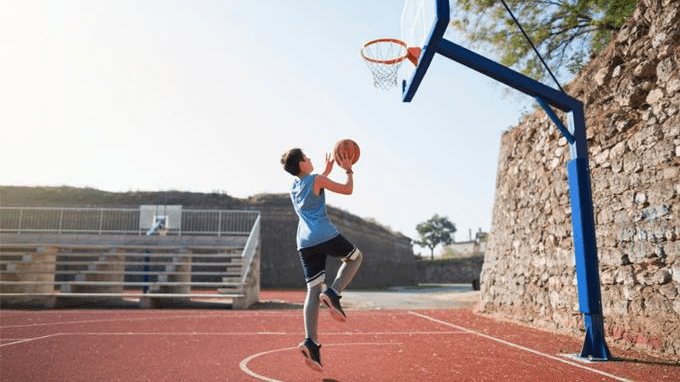Every young basketball player wants to play above the rim and be able to dunk the basketball. A steady diet of workouts with explosive jumps will definitely increase your chances. Explosive jumping exercises can be very rewarding if done consistently and correctly. These exercises will train your body to react quickly with power, which is what all young basketball players want and can achieve if they train properly. I have listed three top tier explosive jumping exercises to help you to become an elite athlete!
1.) Wall jumps to jump quicker and higher with more power.
Wall jumps are a great way to add power and explosiveness to your game. They will also help you to increase your vertical jump. Wall jumps are a plyometric exercise that directly push your muscles to exert a maximum amount of force in short periods of time. This constant use of maximum force will strengthen your fast twitch muscles, which allows you to become explosive and a more powerful jumper.
Wall jumps can be done anywhere, you don’t necessarily need a wall. You just need some space where your ability to jump straight up and down from a standing position is not hindered. If you are able to touch the backboard of a basketball rim multiple times in a row, you can just use the backboard. If you have neither wall nor rim, jumping straight up in the air, reaching as high as you can will work just fine.
To do a wall jump, stand with your feet 10-12 inches away from the wall and stretch both arms above your head and have a slight bend in your knees. Now that you are in balance and ready to begin, you will start by jumping as high as you can and touch the highest point on the wall with your finger tips. Immediately after you land on the ball of your feet, you jump again the same as the first jump. There is no rest between jumps. It’s a continuous exercise focusing on jumping as high as you possibly can with each jump.
Each succession of 10-20 jumps will be considered a set. This workout requires 3-4 sets for each workout two days a week.
Here is an 8-week wall jump workout:
- Week 1- (3 sets of 12 wall jumps)
- Week 2-(3 sets of 12 wall jumps)
- Week 3-5 (3 sets of 15 wall jumps)
- Week 6 (4 sets of 15 wall jumps)
- Week 7 (4 sets of 18 wall jumps)
- Week 8 (4 sets of 20 wall jumps)
2.) Standing long jumps for explosive drives and strong finishes at the rim!
So if you have worked on your ball handling and dribble drives and you are still not getting to the basket and finishing strong at the rim, the reason may be that your posterior chain (quads, gluts, hamstrings, etc.,) is not strong enough. You are not generating enough power from your lower body which prevents you from getting to the rim and you don’t have the lift to finish strong and make the basket.
“Standing Long jumps are a safe and effective way to add power and explosiveness to your game.”
Standing long jumps, also known as broad jumps, are another form of a plyometric exercise that require your posterior chain and core muscles to contract very quickly with each jump. This quick and powerful contraction done multiple times in short bursts will strengthen your body and give you that explosiveness you need. As you progress and begin to jump faster and further, this action will correlate directly with your explosiveness and power on the basketball court.
To do a standing long jump, you will stand with both feet just about shoulder length apart. Your jump will be a two footed take-off. As you begin to jump, you will swing back both of your arms as you hinge or drop your hips back with a slight bend of the knees to propel you forward. You will land on both feet, while focusing on landing softly with your knees bent. After you gather yourself, you will repeat the jump. Each succession of 6-8 jumps will be considered a set. This workout requires 3-4 sets for each workout two days a week for 8 weeks.
Here is an 8-week standing long jump workout:
- Weeks 1-3 (3 sets of 6 long jumps)
- Weeks 4-6 (4 sets of 6 long jumps)
- Weeks 7-8 (4 sets of 8 long jumps)
Due to the nature of this exercise and the impact on your joints, I don’t recommend you do this particular workout more than twice a week. You should also rest at least 45-60 seconds in between sets. Your muscles should be rested and replenished before starting each set. If you want to keep track of your progress, you can time your jump and measure your furthest jump. Each week you can focus on jumping faster and further by using the data you’ve collected.
3.) Standing jump squats for power and impressive vertical jumps!
Standing jump squats are an excellent plyometric exercise that combines power training with cardio endurance. Each jump is causing your posterior chain (quads, gluts, hamstrings, etc.,) to contract very quickly with a large amount of force while kicking your cardiovascular system into overdrive. When playing basketball, the game causes you to constantly jump and move with power and quickness. While being able to do this, you must have the endurance to sustain the energy you will need for an entire game.
To perform a jump squat, legs are slightly wider than shoulder width apart. Drop your hips (hip hinge), lower your thighs to parallel with the floor, keep your core tight and chest up, then explode up by jumping as high as you can. As you jump, you can start with both hands up in front of you, swing your arms up to propel you as you jump. When you land, you want to focus on landing softly without locking your knees. Reestablish your position, then you will continue to keep squatting and jumping in succession.
Each set will be 8 – 12 jumps depending on the week. All jumps will be done in place, there is no running or moving forward and backwards. You will stand in one place and jump up from a squat position as high as you can.
Starting in Week 6, you will add weights such as dumbbells or kettlebells to add resistance. When using weights your technique will be the same as without weights. The only difference is that you will hold the weights in each hand lowered on both sides of your body. As you descend and then jump up, you will hold the weights steady by your side while you jump.
The weights should not move that much as long as you hold them against your side with arms locked throughout the entire motion. The amount of weight added is based on the athlete’s discretion. I recommend to start with 10-20lbs and increase the weight by 5 lb. increments as you progress.
Here’s an 8-week workout of standing jump squats to be done 2x a week progressing to adding weights:
- Week 1-3 (3 sets of 8 jump squats)
- Week 4 (3 sets of 10 jump squats)
- Week 5 (3 sets of 12 jump squats)
- Week 6 (3 sets of 8 jump squats adding 10-20lbs of weight on each arm)
- Week 7 (3 sets of 10 jump squats w/ 10-20lbs of weight on each arm)
- Week 8 (3 sets of 12 jump squats. Increase the amount of weight by 5lbs)
Conclusion: Explosive jumping exercises are key to your basketball development. These exercises are a fantastic way to increase your power, explosiveness, vertical jump, quick jumping ability, and cardio endurance. Unless you have crazy genetics or you have inherited these capabilities naturally, you will need to work hard in the gym to increase your athletic ability with these types of training. These trainings should be paired with specific skill training such as shooting, dribbling, driving, etc.
When training with explosive jumps, you must keep in mind how taxing they are on your body. So, in one workout, you should try to stay in the range of 40-50 jumps. Also make sure you rest at least 45-60 seconds in between sets to make sure your body is prepared for the next set of jumps. If you take the challenge and do these three workouts for 8 weeks, you will reap the benefits as you become a better and more explosive basketball player!
Coach Dell J (Michigan)
www.coachup.com/coaches/dellj
coachupdellj4488- Instagram
DellJCoachup- Twitter
CoachUp is the safest and easiest way to find a coach for personalized training. With our 100% money-back guarantee and vetted coaches, anyone can achieve their full athletic potential. Find your perfect coach today and become the athlete you want to be!
How useful was this post?
Click on a star to rate it!
Average rating 4.5 / 5. Vote count: 2
No votes so far! Be the first to rate this post.



